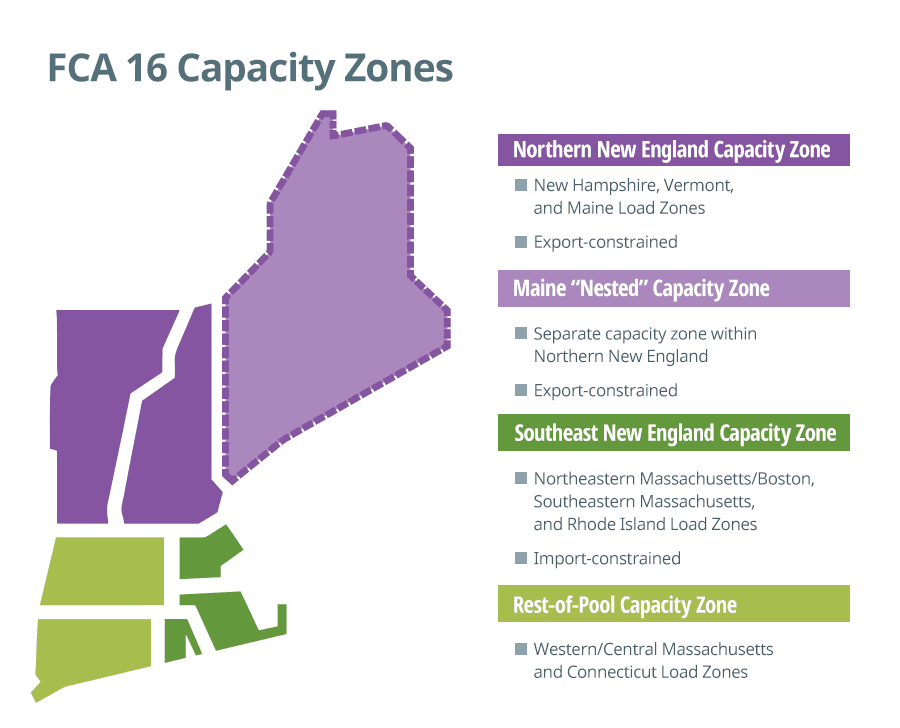FERC accepts capacity requirements for 2025-2026; Forward Capacity Auction 16 set for February 7

The Federal Energy Regulatory Commission (FERC) recently accepted ISO New England’s proposed Installed Capacity Requirement (ICR) and related values for the sixteenth Forward Capacity Auction (FCA 16).
Scheduled to begin on February 7, the auction will procure the capacity resources—including traditional power plants, renewable generation, imports, and demand resources such as load management and energy-efficiency measures—needed to meet the region’s projected demand for electricity from June 1, 2025 to May 31, 2026.
The ISO submitted two documents for FERC’s review ahead of the auction:
- The ICR filing provides a detailed description of the ICR and related values associated with the system and zonal demand curves used in the auction.
- The informational filing provides technical details about the auction, including the capacity resources qualified to participate and the capacity zones that will be modeled based on characteristics of the transmission system.
Installed Capacity Requirement
The ICR is the minimum level of capacity needed to meet reliability requirements for New England’s power system.
FERC accepted the ISO’s proposed ICR of 32,568 megawatts (MW) for FCA 16. The figure assumes 1,830 MW in aggregate emergency assistance available from New Brunswick, New York, and Québec. The ICR does not include 923 MW in Hydro-Québec Interconnection Capability Credits. With those credits, the net ICR is 31,645 MW.
Capacity Zones
For each auction, the ISO studies transmission constraints and sets capacity zones that signal areas of the power system with a potential shortfall or surplus of capacity. Multiple zones help ensure that capacity is located and priced appropriately.
Four capacity zones will be modeled in FCA 16.

A capacity zone is export-constrained if its available resources, after serving local demand, exceed the area’s transmission capability to export the excess electricity. The ISO sets a maximum capacity limit in these zones that can be used to meet New England’s demand for electricity. For FCA 16, the limit is 8,555 MW in the Northern New England Capacity Zone and 4,095 MW in the Maine “Nested” Capacity Zone.
Import-constrained capacity zones do not have enough local generating resources and transmission import capability to reliably serve local demand. For these zones, the ISO sets a local sourcing requirement—a minimum amount of capacity that must be electrically located within the zone. The FCA 16 local sourcing requirement for the Southeast New England Capacity Zone is 9,450 MW.
New Methodologies
Beginning this year, the ISO used new methodologies to calculate three different components of the ICR and related values. They included:
- a new modeling methodology for battery storage resources that are co-located with intermittent power resources and participate in the Forward Capacity Market as non-intermittent resources, as well as a new modeling methodology for stand-alone battery storage resources; and,
- a new methodology to calculate the availability of active demand capacity resources.
In addition, a new methodology for reconstituting passive demand resources, which FERC accepted in 2020, was implemented for the first time this year.
The ICR filing explains these new methodologies in detail.
Related Auction Inputs
The ISO’s FCA 16 informational filing included other important auction inputs:
- The ISO qualified a total of 33,356 MW of existing capacity resources to participate in the auction, including:
- 30,080 MW from existing generating resources (intermittent and non-intermittent),
- 0 MW from existing import resources, and,
- 3,275 MW from existing demand resources.
- A total of 503 MW of Static De-List Bids were submitted.
- The ISO qualified 302 new capacity resources totaling 5,246 MW to participate in the auction.
- Categories
- Inside ISO New England
- Tags
- FCA 16, wholesale markets
